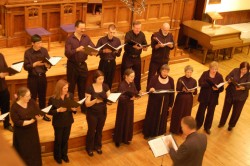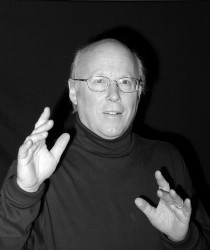 The easiest way to understand music’s place in our lives is to compare it to food. What are you in the mood for tonight? Perhaps you’re willing to brave an exotic, unfamiliar meal from a distant land. Maybe you’re looking forward to a familiar dish, which a notable chef promises to create anew with daringly unconventional spices, sauces and cooking practices. Or after a long week’s work, it may be time for nothing better than comfort food, not especially healthy but familiar and filling for the soul.
The easiest way to understand music’s place in our lives is to compare it to food. What are you in the mood for tonight? Perhaps you’re willing to brave an exotic, unfamiliar meal from a distant land. Maybe you’re looking forward to a familiar dish, which a notable chef promises to create anew with daringly unconventional spices, sauces and cooking practices. Or after a long week’s work, it may be time for nothing better than comfort food, not especially healthy but familiar and filling for the soul.
In music as with food, proper nourishment is achieved through balance. A steady diet of music that is redolent with sophistication and subtlety may yield a kind of spiritual dyspepsia and a desire for more straightforward, meaty fare. But an unbroken chain of fat-fried musical hamburgers is likely to bring on metaphysical bloat of the brain and hardening of the aesthetic arteries.
For composers, the monetary rewards of laying on the musical sugar-treacle must be tempting, as the popularity of Rutter and Lauridsen can demonstrate. On the other hand, proud and uncompromising creators who proffer a musical meal that is the aural equivalent of dry wooden sticks garnished with razor blades should not be overly surprised or aggrieved if most audience members politely decline the invitation.
This month’s column focuses on the familiar and its opposite. Nine out of ten Canadian choral clinicians urge concert-goers to choose at least one of each category in the coming weeks, for proper health and a balanced musical diet.
The weeks surrounding Good Friday are a common time of year to perform settings of the Requiem Mass text. On May 7 and 8, the Cantemus Singers sing Palestrina’s Missa Papae Marcelli, which history has deemed his most popular mass setting. French composer Maurice Duruflé’s popular setting can be heard on April 2, sung by the Alata Harmonia Chorus of Canada, and on April 22, Good Friday evening, at the All Saints Kingsway Anglican Church.
On April 9, the Amadeus Choir performs Mozart’s Mass in C Minor and Haydn’s Lord Nelson Mass. This work, written during the height of Austria’s involvement in the Napoleonic wars, is considered by some to be Haydn’s greatest choral achievement. Other concerts with music by Verdi, Bach, Brahms and Handel can be found in the listings.
Let us turn to premieres, lesser-known works and Canadian composers. Now don’t flip the page or touch that computer mouse, you big scaredy-cats. I promise you that yummy aural snacks await, even if the tastes and recipes are not always entirely familiar.
 On May 7, Cantores Celestes Women’s Choir presents a program that includes Montreal composer Donald Patriquin’s Canadian Mosaic. Patriquin is an inventive and adept choral writer whose work deserves more hearing in this part of the world.
On May 7, Cantores Celestes Women’s Choir presents a program that includes Montreal composer Donald Patriquin’s Canadian Mosaic. Patriquin is an inventive and adept choral writer whose work deserves more hearing in this part of the world.
On May 1, the DaCapo Chamber Choir premieres Gerard Yun’s We Have Not Heard. This concert is part of the excellent Open Ears Festival, which runs from April 27 to May 1 in Kitchener. Specializing in non-traditional music making, this is one of the best modern music festivals around. It deserves much more attention, especially from audiences and media in the GTA.
The Upper Canada Choristers’ May 6 concert Come to the Ceilidh! has a Celtic theme with songs composed or arranged by Canadian composers Mark Sirrett, Stephen Hatfield, Stuart Calvert, Gary Ewer and Harry Somers. Somers in particular was a tough-minded modernist, and it is good to see choirs continue to meet the challenge of his music.
On April 9, the Healey Willan Singers give the Canadian premiere of English composer David Bendall’s Requiem setting. On April 22, the Metropolitan Festival Choir gives a Good Friday concert which features the Canadian premiere of Bob Chilcott’s Requiem, and a number of Canadian works as well. Chilcott was a member of the renowned King’s Singers before embarking on a distinguished career as a choral composer.
This is also a season of premieres for the Orpheus Choir of Toronto. On April 2, they present Eriks Esenvalds’ Passion and Resurrection, and Howard Goodall’s Eternal Light. (On May 11 they debut Imant Raminsh’s Quaternity: A Cantata of Seasons. Raminsh is a Latvian Canadian composer based on the country’s west coast, but he has had a fruitful relationship with many Ontario choirs.)
Three concerts are worth noting that bridge the gap between familiar and novel. Pax Christi Chorale and the Pax Christi Youth Choir give an April 17 concert in support of their audaciously titled new CD Great Canadian Hymns. This collection of all-new compositions is intended for use in church worship services. Nowhere more often than in a discussion of hymn-singing does one hear the phrase, “I like the old ones better,” so a new CD designed for such use is a welcome thing.
On May 7, the Toronto Children’s Chorus sings two relatively unfamiliar works by familiar composers, Brahms’ Four Songs for Two Horns and Harp and Verdi’s Laud Alla Vergine Maria. The former work is particularly beautiful, and worth hearing live.
Finally, a concert series that exemplifies the combination of old and new is Tafelmusik’s rendering of Beethoven’s Symphony No. 9 (April 7-10). Although this orchestra has played Beethoven before, this is its first foray into a work that is normally the purview of enormous choral forces.
The last movement of this symphony is both historically important and undeniably popular, yet many Beethoven aficionados find it the least satisfactory section of the work. Certainly, it is the symphony’s most loosely constructed movement. Personally, when I hear the oom-pah percussion of the tenor solo section, I immediately want to go a-wandering, my knapsack on my back, val-da-ree, etc. But for the vast majority, there is no denying the unique power of the choral movement, especially the taut mixture of serenity and tension in the final B Major interlude before the marching band-like race to the finish.
Benjamin Stein is a Toronto tenor and theorbist. He can be contacted at choralscene@thewholenote.com.



